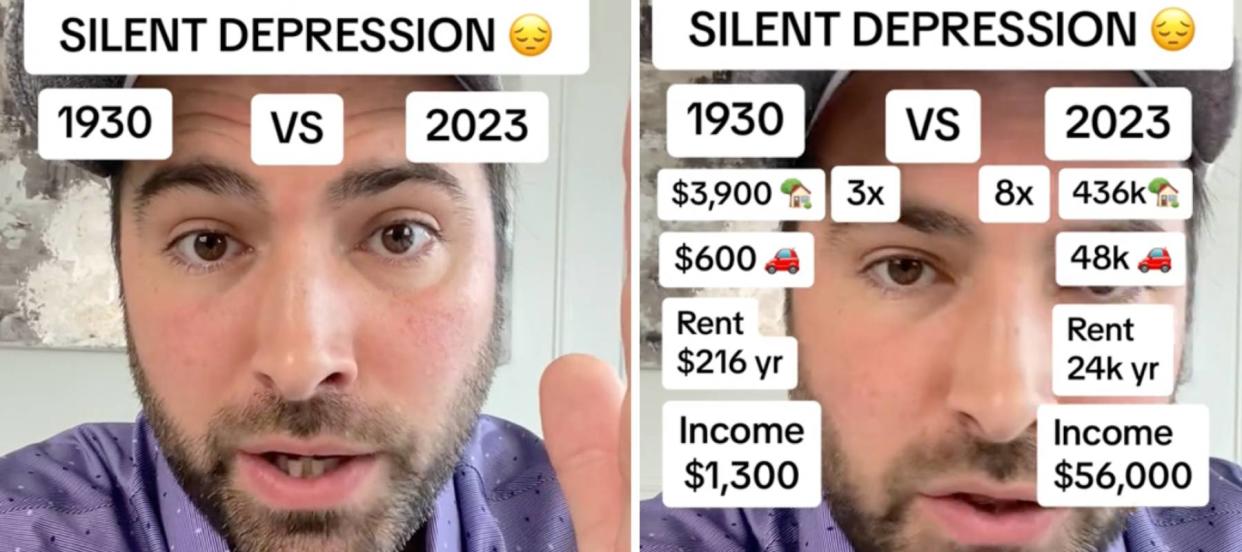'We're in a silent depression': This TikToker went viral for comparing America in 2023 with the Great Depression of the 1930s — claims the data will 'absolutely blow your mind.' Is he right?

With low unemployment, robust GDP growth, and a buoyant stock market, America appears to be performing well economically. But there is a notable disconnect on social media, where many express a starkly different sentiment about the nation’s economic health.
In a viral TikTok video, Freddie Smith, a real estate agent in Orlando, Florida, draws an intriguing comparison between the current economic conditions in America and those during the Great Depression.
“We’re in a silent depression,” he said. “When you compare the Great Depression to today, this is going to absolutely blow your mind.”
Don’t miss
Millions of Americans are in massive debt in the face of rising rates. Here's how to get your head above water ASAP
Save big on your holiday shopping with an app that’s already saved users $800 million
Find out how to save up to $820 annually on car insurance and get the best rates possible
Smith proceeded to examine the cost of living and average income across the two periods in question.
“During the Great Depression, the average home in America was $3,900, the average car was $600, and the average monthly rent was $18 or $216 a year, and the average salary was $1,300 for the year,” he said.
“Fast forward to today it is $436,000 for the average home, $48,000 for the average car and the average rent is $2,000 A month or $24,000 a year. We have a $56,000 income for the average American right now.”
Smith’s numbers suggest that the cost of living has dramatically outpaced income growth.
“If you look back to the Great Depression, the house was only three times the average salary. Now it is eight times the average salary. The car was 46% of the salary. The car today is 85% of the salary. And here's the craziest part — the rent was 16% of the average salary, it is now 42% of the average salary,” he continued.
Then and now
Smith’s argument seems to resonate with a lot of TikTok users, and for good reason. Wages in the U.S. have stagnated for decades, even as productivity increased much faster. The video on “silent depression” has received 8.7 million views and over 781,000 likes.
While the costs of many necessities like housing and transportation have increased disproportionately compared to average incomes, it’s important to note that there are other fundamental factors that characterized the Great Depression.
For instance, during the Great Depression, America experienced significant unemployment, leading to widespread poverty and hardship. For several months in 1933, the U.S. unemployment rate exceeded 25%.
Read more: Thanks to Jeff Bezos, you can now use $100 to cash in on prime real estate — without the headache of being a landlord. Here's how
America is not grappling with those kinds of numbers today. According to the Labor Department’s latest jobs report, nonfarm payrolls increased by 150,000 in October 2023, while the unemployment rate was 3.9% for the month.
Moreover, the Great Depression was precipitated by a catastrophic stock market crash. On October 28, 1929, dubbed "Black Monday," the Dow Jones Industrial Average fell by nearly 13%. The next day, labeled "Black Tuesday," saw an additional drop of nearly 12% in the market.
This downward trend persisted until the summer of 1932, at which point the Dow had plunged 89% from its peak. Countless people saw their investments evaporate, leading to a severe decline in the public's confidence in the financial system.
Fast forward to the present, the investment climate appears significantly more favorable and stable: the Dow has climbed 9% in 2023 and is up more than 48% over the past five years.
Additionally, the Great Depression was characterized by a substantial contraction in economic output. From 1929 to 1933, real GDP in the U.S. fell by 29%.
Such a contraction is not evident in today’s economy. According to the most recent estimate from the Commerce Department, real GDP in the U.S. increased at an annual rate of 5.2% in the third quarter of 2023, up from the initial estimate of 4.9%.
What to read next
Owning real estate for passive income is one of the biggest myths in investing — but here's how you can actually make it work
The US dollar has lost 87% of its purchasing power since 1971 — invest in this stable asset before you lose your retirement fund
Finish 2023 stronger than you started: 5 money moves you should make before the end of the year
This article provides information only and should not be construed as advice. It is provided without warranty of any kind.
